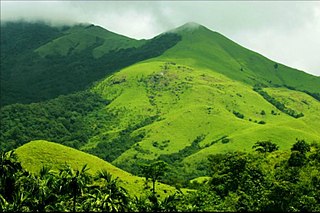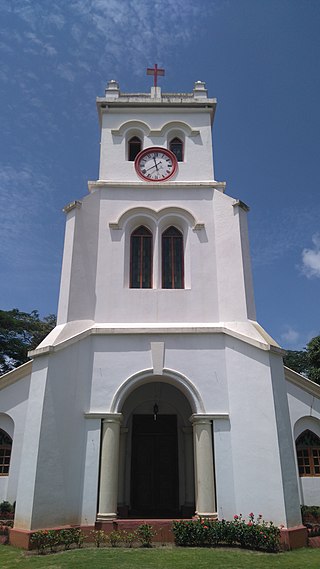Related Research Articles

Kodagu district is an administrative district in the Karnataka state of India. Before 1956, it was an administratively separate Coorg State, at which point it was merged into an enlarged Mysore State.

Mangalore, officially known as Mangaluru, is a major industrial port city in the Indian state of Karnataka and on the west coast of India. It is located between the Laccadive Sea and the Western Ghats about 352 km (219 mi) west of Bangalore, the state capital, 14 km north of Karnataka–Kerala border and 297 km south of Goa. Mangalore is the state's only city to have all four modes of transport—air, road, rail and sea. The population of the urban agglomeration was 619,664 according to the 2011 national census of India. It is known for being one of the locations of the Indian strategic petroleum reserves.

Madikeri is city and headquarters of Kodagu district in the Karnataka state of India. It is recognised as one of the world's eight "hottest hotspots" of biological diversity and also one of UNESCO World Heritage Sites.

Dakshina Kannada district is located in the state of Karnataka in India, with its headquarters in the coastal city of Mangalore. The district covers an area nestled in between the Western Ghats to its east and the Arabian Sea to its west. Dakshina Kannada receives abundant rainfall during the Indian monsoon. It is bordered by Udupi district to the north, Chikmagalur district to the northeast, Hassan district to the east, Kodagu to the southeast and Kasaragod district of Kerala to the south. According to the 2011 census of India, Dakshina Kannada district had a population of 2,083,625. It is the only district in Karnataka state to have all modes of transport like road, rail, water and air due to the presence of a major hub, Mangalore. This financial district is also known as the Cradle of Indian banking.

Sullia is a town in the Dakshina Kannada district of the state of Karnataka, India. It is the headquarters of the Sullia taluk. Sullia is located 300 kilometres west of the state capital Bengaluru.
Arebhashe or Aregannada or Gowda Kannada is a dialect of Kannada mainly by Gowda communities in the region Madikeri, Somwarpet, and Kushalnagar taluks of Kodagu district, Sullia, taluks of Dakshina Kannada district; Bangalore and Mysore districts in the Indian state of Karnataka. As well as Bandadka, Kasaragod District in the Indian state of Kerala, Arebhashe is also called Gowda Kannada. The language was recognized by the Karnataka State government and formed an academy in 2011 to preserve the culture and literature of the Arebhahse Region which is named as Karnataka Arebhashe Samskruthi mathu Sahitya Academy supported by then Chief Minister D. V. Sadananda Gowda.

The Kodava people or Kodavas or Codavas are an endogamous Dravidian ethno-linguistic group from the region of Kodagu in the southern Indian state of Karnataka, who natively speak the Kodava language. They are traditionally land-owning agriculturists and patrilineal, with martial customs. Kodavas worship ancestors and weapons. They used to worship swords, bows, arrows and later guns. Hence, Kodavas are the only ones in India permitted to carry firearms without a license.

The district of Kodagu in present-day Karnataka comprises the area of the former princely state of the same name.

Subramanya is a village located in Kadaba Taluk in Dakshina Kannada, India. The Kukke Subrahmanya Temple is located here. It is about 105 kilometres (65 mi) from Mangalore, connected by train and road. It was originally named "Kukke Pattana".

The Shoranur–Mangalore section, also known as Shoranur–Mangaluru section, is a railway segment of IR functioning under Palakkad Division of Southern Railway Zone. This is a 5 ft 6 in broad gauge electrified line which begins at the Shornur Junction railway station in Kerala and ends at the Mangalore Central railway station in Karnataka. This line passes through major towns including Tirur, Kozhikode, Vatakara, Thalassery, Kannur, Payyannur, Kanhangad and Kasaragod.
Jeevaraj Alva was an Indian politician from the State of Karnataka. He held multiple portfolios such as Kannada and culture, youth affairs and sports, higher education and information in the government of Karnataka. Alva was serving as vice-president of the Janata Dal (United) when he died in 2001, aged 53.
Tulu Gowda and Arebhashe Gowda (Gauda) are primarily found in South Canara District, Kodagu District, Indian state of Karnataka and Bandadka village of Kasaragod. They are officially considered a subsect of the Vokkaliga community but are culturally and linguistically different. They speak Tulu and Arebhashe.

Basavaraj Somappa Bommai is an Indian politician and engineer who is currently serving as the Lok Sabha MP of Haveri and previously served as the 23rd Chief Minister of Karnataka from 18 July 2021 to 19 May 2023. He formerly served as the Interim Leader of the Opposition in Karnataka Legislative Assembly as a member of the Bharatiya Janata Party and he was former member of the Janata Dal and Janata Dal (United). He was a Member of the Legislative Assembly in the legislature of Karnataka for Shiggaon, from where he has been elected four times since 2008. Between 1998 and 2008, he was a member of the Karnataka Legislative Council from Dharwad local authorities. He served as Minister for Water Resources and major and medium irrigation from 2008 to 2013, Home Affairs, Law and Parliamentary Affairs and Cooperation between 2019 and 2021 minister in charge of Haveri and Udupi districts from 2019 to 2021.

St. Paul's Church is an Anglican church in Mangalore, India.

Pahari Mandir is a temple located in hilltop in Ranchi the capital of Jharkhand. The temple is dedicated to Shiva. This temple is located at 2140 feet above sea level and 350 feet above the ground. Shiva is worshiped in linga form in the hill temple. There is a large crowd of Shiva devotees come here during the month of Shivaratri and Sawan.
Kunchadka is a small village in the southern state of Karnataka, India. It is located in the Aletty Village, Sullia taluk of Dakshina Kannada district in Karnataka.
Ammembala Balappa was an Indian freedom fighter and socialist leader who is known for participating in the Quit India Movement in 1942. He played an important role in drafting the Declaration of land policy by the D. Devaraj Urs government during prime minister Indira Gandhi's tenure. He is also credited for founding the first Tulu language newspaper Tulu Siri in 1970.

The Amara Sullia Rebellion was an armed uprising against the British government organized by the people of Arebhashe, and Tulunadu that took place in 1837, twenty years before the Sepoy Mutiny of 1857.

Guddemane Appaiah Gowda was an Indian freedom fighter and revolutionary, he instated a peasant army from Kodagu and became its commander in-chief to lead the Amara Sullia Rebellion in 1837. His great grandson Sujith Guddemane is prominent lawyer from Sullia, practising before the High Court of Karnataka. They were successful in hoisting the native flag after lowering the Union Jack, which is known to be the first-ever freedom movement against the East India Company. They established a civil government in Mangalore for 13 days under his leadership.
References
- ↑ Paniyadi, Gururaj A. (6 April 2016). "1837: When the rebel flag fluttered high". Deccan Chronicle. Retrieved 17 August 2021.
- ↑ "Memorial for martyrs to come up in Bengaluru, says CM Bommai". Deccan Herald. 19 November 2022.
- ↑ Bureau, The Hindu (28 August 2022). "Kedambady Ramayya Gowda's statue to be brought to Mangaluru on August 29". The Hindu.
{{cite web}}:|last1=has generic name (help) - ↑ "Kedambadi Ramaiah Gowda history: ಸಮರವೀರ ಕೆದಂಬಾಡಿ ರಾಮಯ್ಯ ಗೌಡರ ಪ್ರತಿಮೆ ಅನಾವರಣ ಇಂದು; ಅವರು ಯಾರು? ಇತಿಹಾಸ ಏನು?".
- ↑ "Amara Sullia uprising gets due recognition on its 185th anniversary". Deccan Herald. 6 April 2022.
- ↑ S, Umesh Kumar. "Kedambadi Ramaiah Gowda history: ಸಮರವೀರ ಕೆದಂಬಾಡಿ ರಾಮಯ್ಯ ಗೌಡರ ಪ್ರತಿಮೆ ಅನಾವರಣ ಇಂದು; ಅವರು ಯಾರು? ಇತಿಹಾಸ ಏನು?". Kannada Hindustan Times (in Kannada).
- ↑ "Mangaluru: Bommai unveils freedom fighter Kedambadi Ramaiah Gowda's statue". www.daijiworld.com.